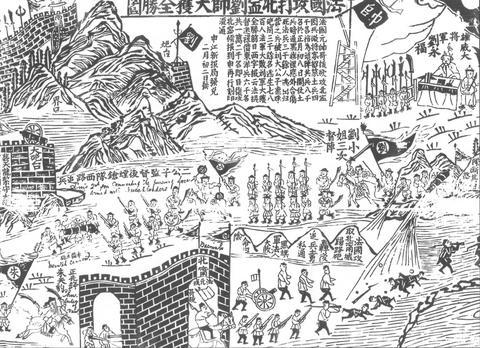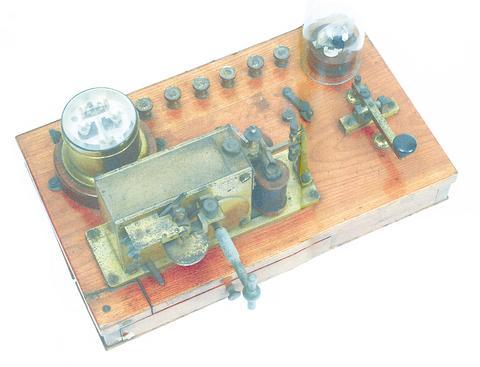Those with a curiosity about military history and a moderate level of Chinese-language ability should find the recently reopened National Taiwan Museum's (
Organized by the museum and with the help of the France's Musee National de la Marine, Service Historique de la Marine and the Service Historique de l'Armee de Terre, the exhibit sets out to tell both sides of the bloody story.

PHOTO COURTESY OF THE NATIONAL TAIWAN MUSEUM
The territorial conflict, which was fought from April 1884 to March 1885, saw troops of France's colonial army face off against Qing dynasty forces over Tonquin, or what is today Vietnam. While much of the fighting took place in Vietnam, French troops managed to occupy parts of Fujian and northern Taiwan at one time or another during the conflict and the naval forces of the two powers clashed regularly in the Taiwan Strait.

By late 1884 Taiwan was effectively cut off from the Chinese mainland and the Taiwan operations of the Sino-French War came to an end in October 1884 after the northern port towns of Keelung and Tamsui were ceded to the French. The bloody year-long conflict cost the lives of 10,000 thousand Chinese and roughly 2,100 French troops.
Chronologically arranged with over 300 artifacts, uniforms, maps, charts, photographs and news clippings as well as interesting interactive elements and an accompanying 41-page booklet, the exhibit gives visitors a simple, yet first-rate account of the causes and effects of the Sino-French War.
Visitors are first given a brief introduction to Taiwan and its people at the end of 1800s in a display titled "Prologue to War," which is a predominantly text-based display, before marching into the War Rooms.
The first war room gives visitors a blow-by-blow account of French naval forces. Along with an interesting chart in which the French ships' names, fire power and man power are listed, a huge painting of French ships and marines clashing with Qing troops at Kim Pai (
The mismatched nature of the conflict continues to be apparent when looking at the weaponry on display in War Room III, where a selection of Chinese matchlock rifles look like toys when compared to the Mausers of the French army. And when visitors learn that Qing troops armed with spears were pitched against French Legionnaires equipped with Winchester repeating rifles, well, enough said.
It might lack the grandiose scale of an exhibition at one of the world's larger museums, but the National Taiwan Museum's "1884-1885: The Sino-French War and Taiwan" makes for an interesting and educational 45 minutes. And, more importantly, visitors will probably leave the exhibit knowing something they didn't before they went in.
"1884-1885: The Sino-French War and Taiwan" (

Wooden houses wedged between concrete, crumbling brick facades with roofs gaping to the sky, and tiled art deco buildings down narrow alleyways: Taichung Central District’s (中區) aging architecture reveals both the allure and reality of the old downtown. From Indigenous settlement to capital under Qing Dynasty rule through to Japanese colonization, Taichung’s Central District holds a long and layered history. The bygone beauty of its streets once earned it the nickname “Little Kyoto.” Since the late eighties, however, the shifting of economic and government centers westward signaled a gradual decline in the area’s evolving fortunes. With the regeneration of the once

Even by the standards of Ukraine’s International Legion, which comprises volunteers from over 55 countries, Han has an unusual backstory. Born in Taichung, he grew up in Costa Rica — then one of Taiwan’s diplomatic allies — where a relative worked for the embassy. After attending an American international high school in San Jose, Costa Rica’s capital, Han — who prefers to use only his given name for OPSEC (operations security) reasons — moved to the US in his teens. He attended Penn State University before returning to Taiwan to work in the semiconductor industry in Kaohsiung, where he

In February of this year the Taipei Times reported on the visit of Lienchiang County Commissioner Wang Chung-ming (王忠銘) of the Chinese Nationalist Party (KMT) and a delegation to a lantern festival in Fuzhou’s Mawei District in Fujian Province. “Today, Mawei and Matsu jointly marked the lantern festival,” Wang was quoted as saying, adding that both sides “being of one people,” is a cause for joy. Wang was passing around a common claim of officials of the People’s Republic of China (PRC) and the PRC’s allies and supporters in Taiwan — KMT and the Taiwan People’s Party — and elsewhere: Taiwan and

Perched on Thailand’s border with Myanmar, Arunothai is a dusty crossroads town, a nowheresville that could be the setting of some Southeast Asian spaghetti Western. Its main street is the final, dead-end section of the two-lane highway from Chiang Mai, Thailand’s second largest city 120kms south, and the heart of the kingdom’s mountainous north. At the town boundary, a Chinese-style arch capped with dragons also bears Thai script declaring fealty to Bangkok’s royal family: “Long live the King!” Further on, Chinese lanterns line the main street, and on the hillsides, courtyard homes sit among warrens of narrow, winding alleyways and